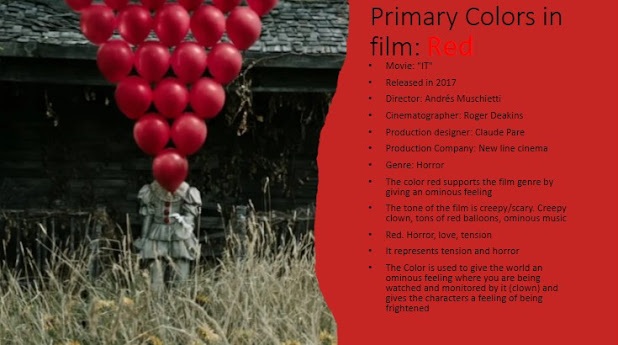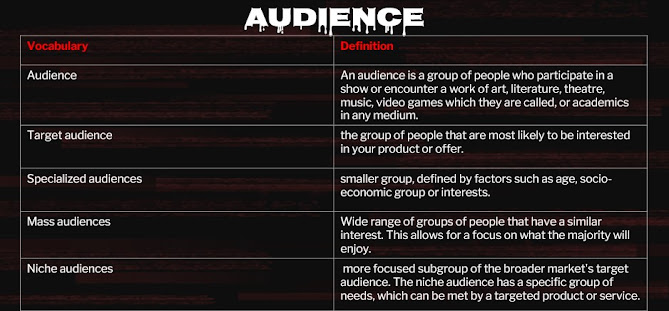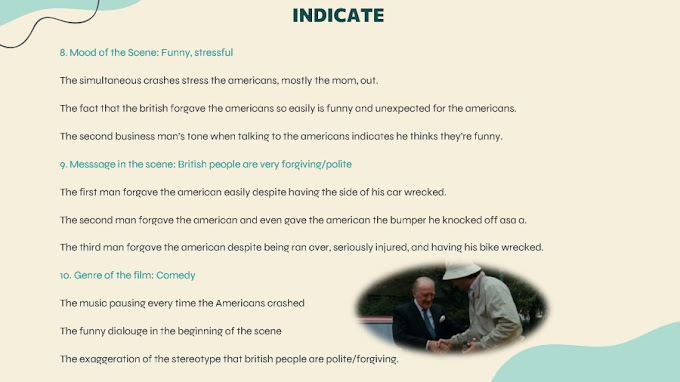The slide of this assignment taught me vocabulary regarding the lesson which can be used again as we move on in class.
Monday, October 31, 2022
Introduction to Color in film Preliminary Exercise 5: Vocabulary
Sunday, October 30, 2022
Introduction to Color in Film Preliminary Exercise 5: Black, white and cool
Color can set the overall tone of the film. For example, the use of purple to create a sense of fantasy. Color can help the film identify character traits, like having a greedy character wear green. Color can also be used to show the evolution of a character or story.
Why is color in film significant to a film's audience?
Color in film is significant to a film's audience because color palette in a film can help tell a story. Color helps the viewer feel certain emotions for example blue undertones are usually used in sad scenes.
List 3 codes used in a film that illustrates color.
-Pink: romantic
-Yellow: happy
-Red: anger
Who is responsible for color in a film?
Colorists are responsible for designing the color scheme of a film.
The objective of the assignment is to create a color wheel Semiotic Analysis Organizer based on Roland Barthes' Theory of Denotative and Connotative Signs. We were to select 5 movies maximum for our Preliminary Exercise for analysis and they were to be from the following genres:
-Drama
-Scifi/fantasy
-Horror
-Comedy
-Action/Adventure
The goal of this preliminary exercise was to create slides analyzing the symbolic meaning of colors in film. We had to research and choose nine frames selected from various movie themes, genres, and mise en scene focused codes to analyze. The slides below have the color study for black, white, and cool color.
This assignment was split up between me and another teammate, Alessandro P. I completed completed secondary colors and white while Alessandro completed primary colors and black. We both worked on the extra cool color slide(slides down below).
This assignment taught me how color can be played with in film to enhance and add more depth to a story. Color in film furthers emotion within a scene. This assignment also further taught how to be able to recognize and define signs both visually and audibly when analyzing media products for the following: denotative and connotative meanings. Creating these slides required getting a full analysis from one singular frame, which proved to be less difficult after realizing how much information can be taken out of just one still frame.
Introduction to Color in Film Preliminary Exercise 5: Secondary Colors
Color can set the overall tone of the film. For example, the use of purple to create a sense of fantasy. Color can help the film identify character traits, like having a greedy character wear green. Color can also be used to show the evolution of a character or story.
-Red: anger
-Pink: romantic
-Yellow: happy
Who is responsible for color in a film?
Colorists are responsible for designing the color scheme of a film.
The objective of the assignment is to create a color wheel Semiotic Analysis Organizer based on Roland Barthes' Theory of Denotative and Connotative Signs. We were to select 5 movies maximum for our Preliminary Exercise for analysis and they were to be from the following genres:
-Drama
-Scifi/fantasy
-Horror
-Comedy
-Action/Adventure
The goal of this preliminary exercise was to create slides analyzing the symbolic meaning of colors in film. We had to research and choose nine frames selected from various movie themes, genres, and mise en scene focused codes to analyze. The slides below have the color study for secondary colors in film: green, orange and purple.
What did I learn?
This assignment taught me how color can be played with in film to enhance and add more depth to a story. Color in film furthers emotion within a scene. This assignment also further taught how to be able to recognize and define signs both visually and audibly when analyzing media products for the following: denotative and connotative meanings. Creating these slides required getting a full analysis from one singular frame, which proved to be less difficult after realizing how much information can be taken out of just one still frame.
Introduction to Color in Film Preliminary Exercise 5: Primary Colors
Color can set the overall tone of the film. For example, the use of purple to create a sense of fantasy. Color can help the film identify character traits, like having a greedy character wear green. Color can also be used to show the evolution of a character or story.
Why is color in film significant to a film's audience?
Color in film is significant to a film's audience because color palette in a film can help tell a story. Color helps the viewer feel certain emotions for example blue undertones are usually used in sad scenes.
List 3 codes used in a film that illustrates color.
-Red: anger
-Pink: romantic
-Yellow: happy
Who is responsible for color in a film?
Colorists are responsible for designing the color scheme of a film.
The objective of the assignment is to create a color wheel Semiotic Analysis Organizer based on Roland Barthes' Theory of Denotative and Connotative Signs. We were to select 5 movies maximum for our Preliminary Exercise for analysis and they were to be from the following genres:
-Drama
-Scifi/fantasy
-Horror
-Comedy
-Action/Adventure
This assignment taught me how color can be played with in film to enhance and add more depth to a story. Color in film furthers emotion within a scene. This assignment also further taught how to be able to recognize and define signs both visually and audibly when analyzing media products for the following: denotative and connotative meanings. Creating these slides required getting a full analysis from one singular frame, which proved to be less difficult after realizing how much information can be taken out of just one still frame.
Thursday, October 20, 2022
Activity 3 Group Project: annotating costume, hair, makeup, setting and acting with elements
-Setting: refers to the time and/ or place that the narrative occurs, whether indoors or outdoors.
-Costume: clothes that actors wear.
-Hair and Makeup: used to convey a character's status or personality.
This assignment is a group project PowerPoint based of the mise en scene elements of a film opening. The objective of these slides were to pick a specific scene and analyze the elements within that scene. These elements include, acting, setting, costume, hair and makeup.
Me and my teammates split up the PowerPoint into three sections, me being responsible for the first set of slides and my teammates (Alessandro P. and Diviana R.) the other two sections. These two slides above were done by one of my teammates, Diviana R.
What I learned
This assignment has taught me the various ways a character can interpreted based on their surroundings and composition, not just acting. A whole story can be told through just one specific scene, that's the beauty of film-making.
Activity 3 Group Project: Demographic & Psychographic Target Audience
What are demographics?
Demographics are characteristics of an audience that have been categorized by distinct criteria like age, gender and income.
What are psychographics?
Psychographics are consumers or an audience based on their interests, activities and opinions.
What is a target audience?
The intended audience of a media catered specifically to said intended audience.
This assignment is a group project PowerPoint based of the mise en scene elements of a film opening. The objective of this specific slide was to define and study the demographic and psychographic elements of a target audience. We were to name five characteristics of each concept.
Me and my teammates split up the PowerPoint into three sections, me being responsible for the first set of slides and my teammates (Alessandro P. and Diviana R.) the other two sections. The slide above was completed by me.
What I learned
This assignment has taught me the two different ways to target an audience. I always knew there were various ways in which a film maker can cater to their intended audience but never knew the terms for it. Now I know for when we start getting ready to make our film, what to target, whether I decide psychographic, demographic, or both.
Activity 3 Group project: Audience
The types of audiences were the following:
-Audiences
-Target audience
-Specialized audiences
-Mass audiences
-Niche audiences
Working with others is always fun and can make assignments a lot easier. Me and my teammates (Alessandro P. and Diviana R.) split up the PowerPoint into three sections, me being responsible for the first set of slides including the one above. Communication within this specific group was not the best but the assignment got done in the end and gave me a feel for how the upcoming group film is going to be like. Of course, making a film and PowerPoint is nowhere near the same thing but now I know how it's going to be like working with others since it was my first time doing a group project in media studies.
What I learned
I learned a few things from working on this slide. For one, I learned patience and communication after working with my teammates. But most importantly, I learned about the various audience terms in media that film makes use to specify their intentions. Media vocabulary is always useful since it's able to be reused and applied to future project and assignments.
Monday, October 10, 2022
Preliminary Exercise 4: Analyzing Setting for National Lampoon's European Vacation
The objective of this assignment was to watch the video clip from National Lampoon's European Vacation (https://www.youtube.com/watch?v=uQAbek0uOP0) to document and analyze the elements of setting in the film excerpt.
1. Place
2. Geography
3. Time period
5. Physical characteristics of location
6. Culture/ moral values
7. Social and Economic values
8. Mood of scene
9. Message of scene
10. Genre of the film
Tuesday, October 4, 2022
Introduction to Mise en scene Codes Organizer slide
These slides are a part of the whole assignment (originally a PowerPoint). They provide examples of mise en scene codes taken from the movie as well as definitions and then put into an organizer.

Me and my teammates split up the PowerPoint into three sections, me being responsible for the first set of slides and my teammates (Alessandro P. and Diviana R.) the other two sections. The slides above were completed by me.
Monday, October 3, 2022
Preliminary Exercise 3: Mise en Scene Codes and Genre Conventions Bubble Organizer
Mise en Scene is the essence of film making. Essentially the placement of stage and where things go. Mise en Scene film makers focus on storytelling through a single shot. Sound, music, set design, costume, lighting, etc. all go into mise en scene.
The objective of this assignment was to construct a bubble diagram in order to identify common knowledge on movie and television viewing experience. We were to illustrate mise en scene codes for a particular genre, in which I chose horror.
The diagram was made up of the following:
-Color: colors in film illicit certain emotions from the audience and can be encoded symbolics meanings illustrated by film maker.
-Acting: refers to the art of human representation or interpretation of a character within a film.
-Composition: refers to the way elements of a scene are arranged in relation to each other in a camera frame.
-Setting: refers to the time and/ or place that the narrative occurs, whether indoors or outdoors.
-Costumes: clothes that actors wear.
-Hair and Makeup: used to convey a character's status or personality.
-Set design: the creation of the physical space in which the action of a performed event takes place. It also includes the décor and props used to support genre.
-Lighting: lighting setup guides the eye to a specific actor, prop, or part of a scene.
Creative Critical Reflection
My creative critical reflection! I loved putting this PowerPoint together and making it match the film created with our group.

-
Camerawork is the way a camera is angled, shot, or framed in film. Understanding camerawork is very important in order to shoot a scene that...
-
We consume media every day, whether that be through watching television, using our phones, or working with computers. I especially use media...
-
The objective of this assignment was to analyze the elements of setting, acting, costumes, hair, and makeup and how they supported the genr...





















